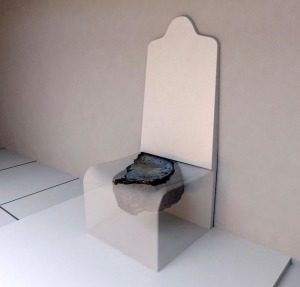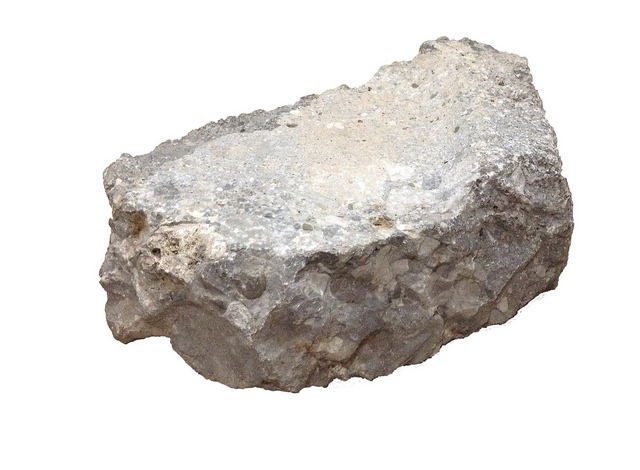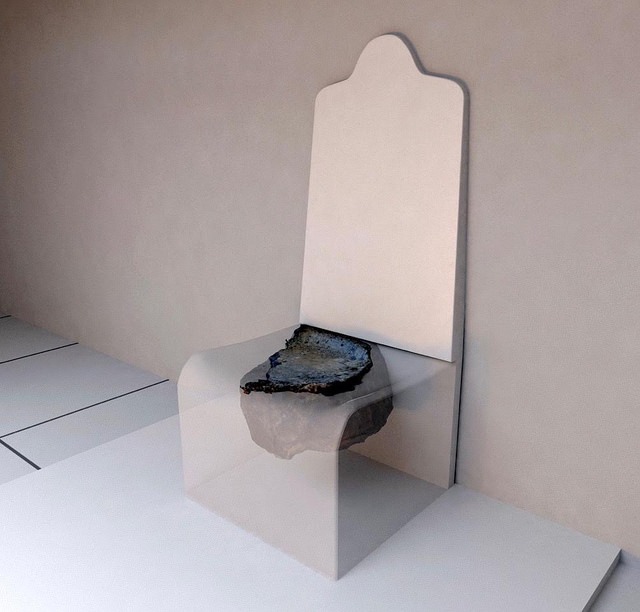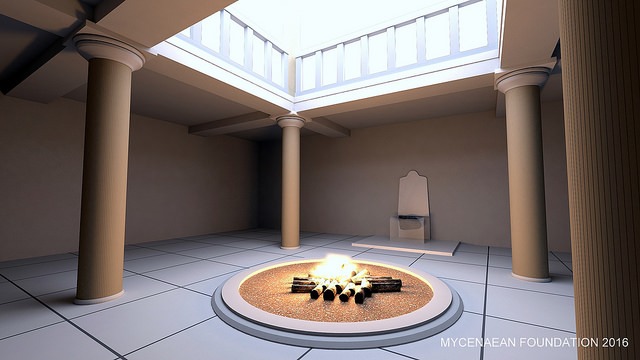
Archaeologists have found and identified a large fragment of what is likely the throne of a Mycenaean king at the site of ancient Mycenae in Greece.
Dubbed the “throne of Agamemnon”, after the famous mythical king who led the united Greek armed forces during the Trojan War, it was first discovered on June 12, 2014 by two research team graduates, Erik deMarche and Dan Fallu, who were working under the leadership of Prof. Christofilis Maggidis (Associate Professor of Dickinson College, President of the Mycenaean Foundation and Field Director of Excavations at the Lower Town of Mycenae and Glas). They were conducting a paleo-hydrological survey in the Chavos ravine on the south side of the famous Mycenaean citadel remains at Mycenae, Greece. It is reported to be the only throne of a Mycenaean palace ever found so far on mainland Greece.
The large stone seat fragment was later studied exhaustively by an interdisciplinary team of specialists for two years (Prof. C. Maggidis, Prof. H. Dierckx, Prof. N. Lianos, Prof. A. Stamos, D. Fallu, E. deMarche) and was securely identified as part of the royal throne of the last phase of the Mycenaean palace at Mycenae (1250-1200 BC). The throne fragment was found literally below the palace, where it had fallen, rolled and subsequently was buried by the river fill, when the southeastern part of the palace, including the throne and one of the four columns surrounding the central hearth, collapsed in the ravine as a result of the catastrophic earthquakes that destroyed the palace of Mycenae and caused extensive damage to the citadel and the town in ca. 1200 BC. The missing column base had already been retrieved 60 years ago in the very same area where the throne was recently discovered.
_______________________________________
The huge stone fragment of the Mycenaean throne. Courtesy the Mycenaean Foundation
__________________________________________________________
Scientists point to a number of factors supporting the identification: (1) the find-spot of the object and related topographical, archaeological, and contextual parameters; (2) the diagnostic morphological/typological traits of the find— its material and technical details, fine carving and polishing, and massive dimensions (originally weighing approximately 250 kg); (3) the stunning similarities with the throne of Knossos in terms of shape, size, and proportions; (4) the analysis of impact traces and breaks; (5) the comparative study of archaeological and iconographical comparanda from the Aegean, Egypt, Anatolia and the Near East; and (6) the examination of ancient literary sources (Linear B and Homeric epics) indicate conclusively that this is a fragment of the stone seat of the monumental royal throne of the palace at Mycenae.
More specifically, the type and shape of the low, flat and wide ledge, which slopes toward the central depression and forms rounded corners (identical with that of the throne of Knossos and other Minoan stone seats), the linear traces of the contact surface of the missing backrest slab (still clearly visible on the upper surface of the rear ledge), the shallow central depression (only 3cm deep – just 0.5cm shallower than that of the throne of Knossos), and the slight sloping of the central depression that deepens towards the rear side (again, identical with that of the throne of Knossos) are diagnostic and indisputable traits of a seat (thus, eliminating all other alternative interpretations of a “basin”, altar, offering table, or mortar).
Furthermore, the use of local limestone conglomerate for the throne would have created the illusion of the hill’s natural bedrock rising within the throne room at Mycenae (echoed by an unhewn bedrock projection in the inner sanctum of Temple Gamma in the Cult Center of Mycenae), thus conveying strong semiological symbolisms of autochthony, antiquity, monumentality, permanence and stability. Three blocks of green serpentine decorated with a relief running spiral that were found in various locations at Mycenae have already been published as possibly belonging to the decorated base of the throne of Mycenae, just like the decorated throne base found at the palace of neighboring Tiryns. Imported conglomerate was selectively used for palatial buildings, wall gates (e.g. Lion Gate), and facades of royal tholos tombs at Mycenae, Tiryns, and Knossos; furthermore, the same combination of conglomerate with green marble or serpentine was used for the decorated façade of the “Atreus Treasury,” the most monumental royal tholos tomb at Mycenae, which was contemporary with the Lion Gate and the last phase of the palace and the royal throne (1250-1200 BC). The choice and combination of materials, therefore, as well as the high quality of fine carving and polishing are clearly of palatial character and reinforce the identification of the royal throne.
The Mycenae throne also presents striking similarities with the Knossos throne and the Tiryns throne base in terms of dimensions and proportions. The Mycenae throne (50cm X 70cm) is more monumental than its Knossian parallel (32.2cm X 45.1cm), but their length-to-width ratio is identical (0.71). The original length of the central depression of the Mycenae throne, estimated at 44.8cm, is longer than that its Knossian counterpart, but quite compatible with the average length of the femurs of the adult skeletons in the shaft graves of Grave Circle A, thus indicating that the Mycenae throne was made for a larger body type, which is in accordance with the comparative anthropometric studies on Minoans and Mycenaeans. The maximum depth of the central seat depression that deepens towards the backrest in both thrones, is almost identical for the Mycenae (3cm) and the Knossos throne (3.5cm), while the thickness of the backrest takes up 63-65% of the width of the backrest in both thrones. Finally, the length-to-width ratio of the base of the Mycenae throne and the Tiryns throne is identical (1.32).
_________________________________________
Graphic representation of the royal throne. Courtesy Mycenaean Foundation
___________________________________________
Graphic representation of the royal throne within the context of the royal throne room. Courtesy Mycenaean Foundation
_________________________________________________________
At Mycenae, the geophysical survey (2003-2016) and systematic excavation (2007-2013) of the Lower Town are conducted by Professor Christofilis Maggidis of Dickinson College USA, President of the Mycenaean Foundation, under the auspices of the Athens Archaeological Society and with the generous support of Dickinson College, the INSTAP, and the Mycenaean Foundation.
The archaeological investigation of the site has revealed houses, storerooms, workshops, roads and graves of a large settlement, which was protected on its south side by a thick fortification wall with two gates. The archaeological excavation of the Lower Town at Mycenae is shedding new light on the everyday life of the Mycenaeans, the dynamics between palace and town, the human impact and systematic transformation of the ancient environment, and the historical, socio-political, economic, and natural parameters that led to the decline and fall of the Mycenaean world. For the first time since the commencement of excavations at Mycenae in the 19th century, the archaeological investigation of the Lower Town has established the existence of a large, organized settlement around the citadel and has documented cultural continuity from the Bronze into the Iron Age at the site with the discovery of successive, superimposed ruins dating to the Mycenaean, Protogeometric, Geometric, and Archaic period (13th – 6th cent. BC).
The scientific importance of the find and its semiological weight as a symbol connected with myth, epic poetry, and ancient literary tradition are undeniably immense. This is one of the most important and emblematic finds of the Mycenaean age. Therefore, its full scientific publication (forthcoming in 2017) is of the utmost importance, while the necessity to fully explore, survey, and excavate a large section of the Chavos ravine is an urgent priority in order to complete the virtual 3-D and actual reconstruction of the royal throne of Mycenae, the so-called “throne of Agamemnon,” the last legendary king of Mycenae in the ‘heroic’ age.
Source: Adapted and edited from the subject press release of the Mycenaean Foundation.
_____________________________________________________

______________________________________________
Travel and learn with Far Horizons.
____________________________________________
This richly illustrated issue includes the following stories: Recent findings shedding new light on the whereabouts of the remains of Philip of Macedon, father of Alexander the Great; how an archaeologist-sculptor is bringing bones of the dead back to life; archaeologists uncovering town life at the dawn of civilization; an exclusive interview with internationally acclaimed archaeologist James M. Adovasio about what makes the Meadowcroft Rockshelter prominent in the ongoing search for the first Americans; what archaeologists are finding at the site of the ancient city of Gath, the home town of the biblical Philistine giant, Goliath; and how scientists are redrawing the picture of human evolution in Europe. Find it on Amazon.com.










